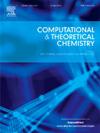Chalcones from the deep: in silico medicinal chemistry and quantum chemical insights into their anticancer and anti-HIV potency
IF 3
3区 化学
Q3 CHEMISTRY, PHYSICAL
引用次数: 0
Abstract
Chalcones obtained from marine sources have become significant frameworks in the discovery of potential innovative therapies. This work thoroughly explored a library of over 100 chalcones for their dual anticancer and anti-HIV potential using combined quantum chemistry and molecular modeling methodologies. DFT simulations at the B3LYP-D3/6-31+G(d) level included HOMO–LUMO, DOS, ESP mapping, and NBO. Molecular docking conducted against two targets, epidermal growth factor receptor (EGFR, PDB ID: 1NQL) and HIV-II protease (PDB ID: 1HSG), revealed the significance of chalcones (C-1, C-3, C-6, and C-9), confirming robust binding affinities (up to −9.48 kcal/mol). MD simulations confirmed the structural integrity of the ligand-protein complexes. To substantiate the computational methods, DFT-derived NMR and IR spectra of an analogue of C-6 (phlorizin) were compared with experimental data, demonstrating remarkable concordance and affirming the theoretical framework. The results underscore the potential of marine chalcones as dual-action therapeutic agents for cancer and HIV therapy.

深查尔酮:在硅药物化学和量子化学洞察其抗癌和抗艾滋病毒效力
从海洋中获得的查尔酮已成为发现潜在创新疗法的重要框架。本研究利用量子化学和分子建模相结合的方法,深入研究了100多种查尔酮的抗癌和抗艾滋病双重潜力。B3LYP-D3/6-31+G(d)水平的DFT模拟包括HOMO-LUMO、DOS、ESP映射和NBO。通过对两个靶点表皮生长因子受体(EGFR, PDB ID: 1NQL)和HIV-II蛋白酶(PDB ID: 1HSG)的分子对接,揭示了查尔酮(C-1, C-3, C-6和C-9)的重要性,证实了强大的结合亲和力(高达- 9.48 kcal/mol)。MD模拟证实了配体-蛋白复合物的结构完整性。为了验证计算方法,将dft衍生的C-6类似物(苯连菌素)的核磁共振和红外光谱与实验数据进行了比较,证明了显著的一致性,并证实了理论框架。这些结果强调了海洋查尔酮作为癌症和艾滋病双重作用治疗剂的潜力。
本文章由计算机程序翻译,如有差异,请以英文原文为准。
求助全文
约1分钟内获得全文
求助全文
来源期刊

Computational and Theoretical Chemistry
CHEMISTRY, PHYSICAL-
CiteScore
4.20
自引率
10.70%
发文量
331
审稿时长
31 days
期刊介绍:
Computational and Theoretical Chemistry publishes high quality, original reports of significance in computational and theoretical chemistry including those that deal with problems of structure, properties, energetics, weak interactions, reaction mechanisms, catalysis, and reaction rates involving atoms, molecules, clusters, surfaces, and bulk matter.
 求助内容:
求助内容: 应助结果提醒方式:
应助结果提醒方式:


